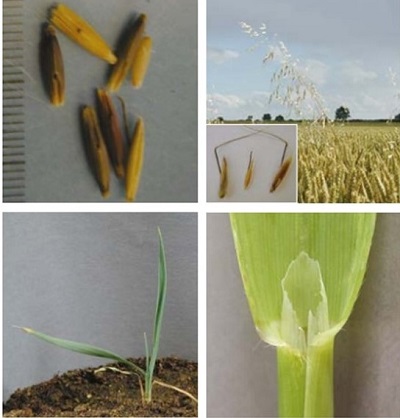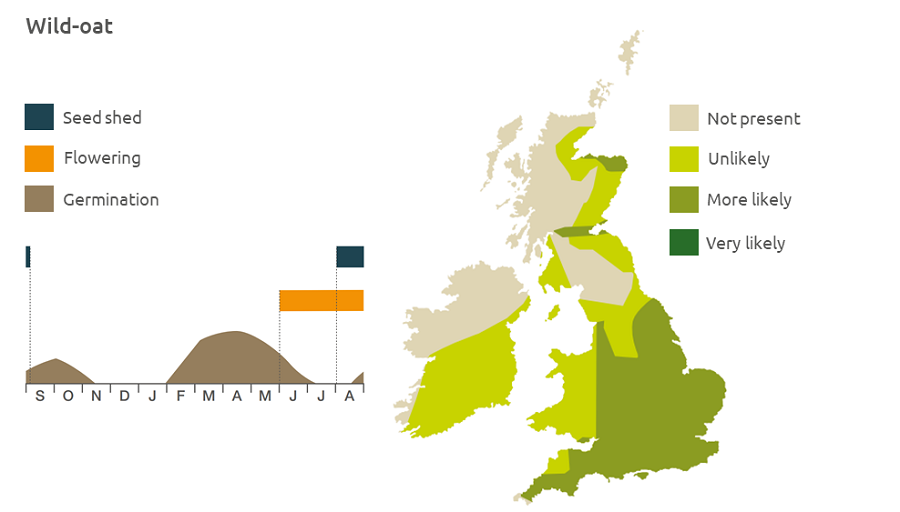- Home
- Knowledge library
- Distribution and biology of wild-oat in the UK
Distribution and biology of wild-oat in the UK
Wild-oat is competitive in arable crops and can reduce cereal yields. Find out how to identify and control it.
Overview
Wild-oats (Avena fatua) reproduce only from seed. Although some germinate in autumn, tiller in early spring and are resistant to frost, most germinate in the spring. One wild-oat plant per square metre can reduce yields by up to 1 t/ha in winter cereals and up to 0.6 t/ha in spring cereals.
- It is particularly competitive in winter wheat, winter oilseed rape and spring crops
Description
It is a tall, stout, annual tufted grass. The leaf blade is broad and flat with an anti-clockwise twist. The flowerhead is spreading with drooping spikelets.
Key features
Plant: The leaf margins are hairy towards the base.
Fruit: There is a tuft of tawny hairs at the base, when ripe, the spikelets break apart with visible scars.
Lookalikes
All the oat species are difficult to tell apart – at the seedling and adult stages.
Winter wild-oat germinates in the autumn, while wild-oat usually germinates in the spring.
Compared with winter wild-oat, the leaf margins of wild-oat are hairier near the base and the spikelets are smaller, lemmas are broader and end in two small teeth. The two species are easier to tell apart when the fruit is ripe, wild-oat seeds separate from the spikelet with no scar.
The ligule of cultivated oat is shorter and blunter than that of wild-oat. The leaves are hairless. When mature, cultivated oat is generally broader-leaved, paler and more robust than wild-oat species.

Location and life cycle

Geographic distribution
Wild-oat is found mainly to the south of Northumberland and in Scottish arable areas. It is a grass of lowland areas but it can grow up to an altitude of 300 m.
Soil type
It prefers highly fertile, moist and weakly acid to weakly alkaline soils.
Seed statistics
- Seed longevity: >5 years
- Seed decline: 50% per year
- Seed weight: 30 mg
- Seeds/spikelet: 2
- Seeds/plant: Up to 200
Management
It is cheaper to control wild-oat in break crops. Delay cultivation as long as possible after harvest to allow mice and birds to eat the freshly shed seeds. Burial will increase seed dormancy. Hand rogueing is possible. Clean the combine between fields to prevent seeds being spread.
For advice on herbicides, please speak with your agronomist or adviser.
Herbicide resistance
Herbicide resistance in wild oat has been detected on over 250 farms and 28 counties, mainly across England*.
Compared to other common grass-weed species, such as black-grass and Italian rye-grass, the rate of selection and spread of herbicide resistance in wild oats has been relatively slow. This is due to the biology of wild oats, in particular their in-crossing and hexaploid characteristics.
Although less problematic than some other weeds, the situation requires careful management.
Resistance is also present in winter wild oat.
*Based on a compilation of data in 2016 from most organisations/companies testing for herbicide resistance in the UK.
When was this information last updated?
This page is based on content from the encyclopaedia of arable weeds publication. Since it was first released in 2008, the publication has been redesigned several times but not revised. However, it remains a good foundation for general information on the distribution and biology of weeds.

